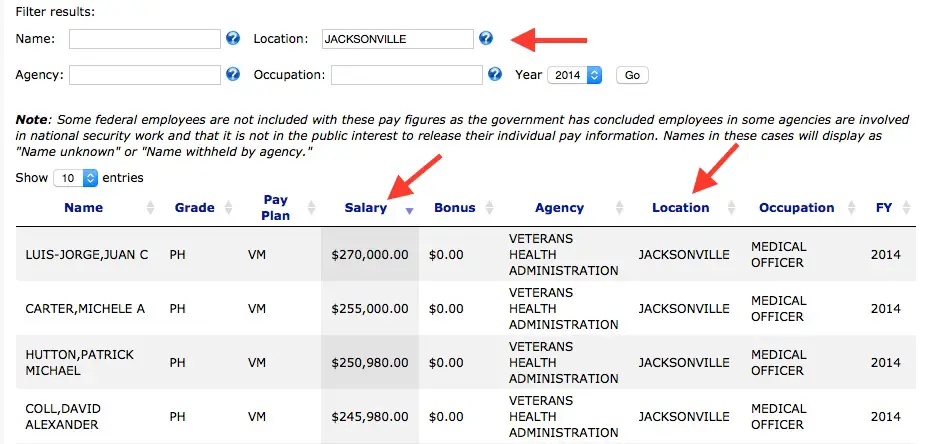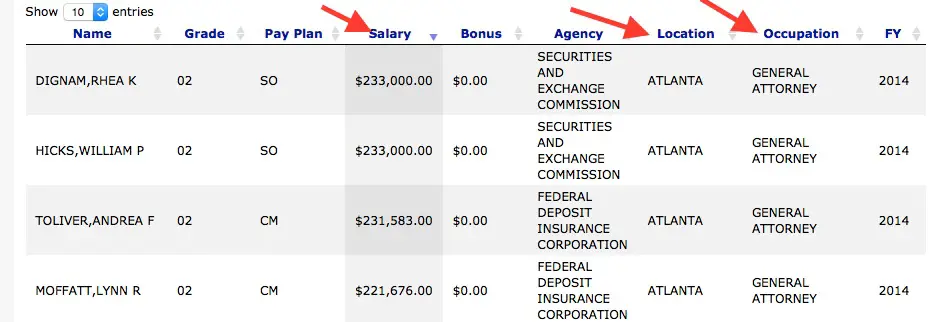Note: You have reached a page with archived content. Please see How to Find Federal Employees’ Salaries by Name for a newer version of this article.
How much does an individual federal employee make in a year?
You can quickly find out using the federal employee salary search on the FedsDataCenter.com website. The salary data is being updated from the time this article was originally published. The search engine now includes data from 2016 and fiscal year 2015. The data from 2016 is more recent but is not as extensive as the data will be from fiscal year 2015, which will include a larger universe of federal employees, when it has been completely uploaded. We are adding data as soon as it becomes available.
Searching on the database is the same as outlined in the original article which used the fiscal year 2014 data. Be sure to use the pulldown menu to select the year on which you prefer to perform your search for individual federal employee salaries.
Data from earlier fiscal years is also available in the same location using the pull down menu of available years starting with 2010.
To make your salary searches on FedsDataCenter.com more efficient, here is a brief explanation explaining ways to successfully use this database.
Search by Name
The most frequent searches on the federal employee salary database are those who want to locate a specific federal employee. To do this, just type in a person’s name into the “name” search block in this format: last name, first name. So, for example, if you are searching for a specific federal employee, just type in a name such as: Johnson, Fred. After typing in the name, click on the “Go” button as illustrated in this graphic:
 After you have performed your search, the data will be displayed with the requested information.
After you have performed your search, the data will be displayed with the requested information.
Sort by Salary Level
When you see the names, you can further narrow your search results.
Ten names are displayed as a default but you can select up to 100 names to be displayed at a time with the pull down menu at the top left of the results (arrow number 1 in the example screenshot below).
If you want to see the highest salaries of federal employees named “Fred Johnson”, just click on the salary column (arrow number 2 in the example screenshot below). With the first click, the names are displayed from the lowest salary to the highest. With the second click on the salary column, the names are displayed from the highest salary to the lowest with the first several names as seen in this graphic which displays information after the second click:
Search by Occupation, Location and Salary
Another common search on the database is to search for people by their occupation.
For example, if you want to see a list of federal employees with the occupation of “General Attorney,” your search results will provide almost 28,000 federal employees with this occupation.
Here is an example of how to narrow down this type of search. In this example, you can locate federal employees with the “General Attorney” occupation located in Atlanta and simultaneously sort the list from their highest to the lowest salaries. To do this,
- Enter the title “General Attorney” in the “Occupation” search block and “Atlanta” in the “Location” block. As you type the job title and occupation into their respective fields, menus of matching results will appear underneath the field and will be narrowed down further as you type. Simply click on a matching result to populate the field.
- Click on the “Go” button to see the results of your search.
- Click twice on the “Salary” column to sort the individual salaries of those in the list from the highest salary to the lowest.

Your top search results will appear as displayed in the next graphic. The arrows indicate the columns used to identify the specific information used to narrow down this list.
The database will sort on any of the columns that are displayed. To sort, just click on the column heading. To reverse the data displayed, click on the column a second time to see the results.
Using the Search Blocks and Sorting Columns
It is also possible to use the search blocks and to sort the columns to narrow down your search results. That was done in the previous example. Here is another example.
- Type Jacksonville into the location search box.
- Click twice on the salary column to sort from the highest to the lowest salaries in Jacksonville, Florida.
- Note that it is only possible to sort with one column to narrow down the information in the database. To further narrow your search, use the search blocks to narrow down your initial data fields.
The results for this example will appear in this way:
Miscellaneous Tips for Searching
Here are several other tips for successfully narrowing down your search of federal employees.
Agencies are often not listed as being under the broad umbrella of the main organization such as the “Department of Agriculture” or the “Department of Veterans Affairs” or the “Veterans Administration.” The agencies providing the information have generally opted not to do that. Of course, with smaller agencies, all employees may be found under the main heading. For example, typing in “Federal Deposit and Insurance Corporation” will yield results of about 7000 employees for the agency.
To quickly find employees in a larger agency, try typing the word “Agriculture” into the search block instead of “Department of Agriculture”. This will display some of the agencies within USDA.
On the other hand, typing in the Natural Resources and Conservation Service will show results for over 10,500 employees of that organization. Typing in Rural Utilities Service will quickly find the 255 federal employees of this agency which is also part of the USDA. These organizations are part of the Department of Agriculture but are not listed under the USDA as that is not how the information was provided to OPM.
Also, for the main database of federal employees, it is possible to search by town but not by the state. For example, typing in Tampa will result in finding about 5700 federal employees working in Tampa, Florida. Typing in “Florida” rather than the name of a town, will not provide any results.
We hope that this brief explanation will helpful in finding the specific salary information you are seeking.



